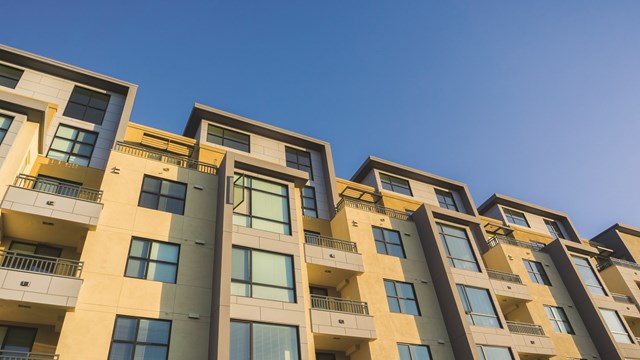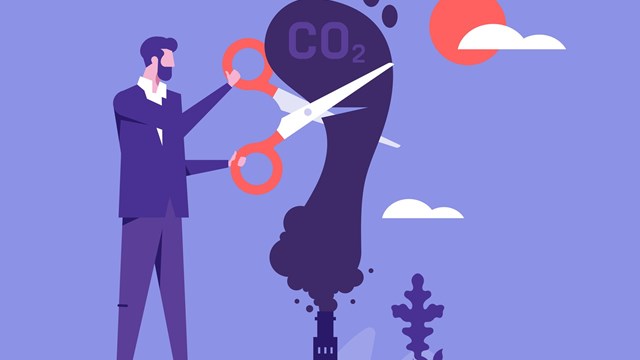
The concept of a “carbon footprint” has been widely circulated in the media for the last couple of years—particularly as global warming has become such an urgent topic of discussion for people other than Al Gore. Essentially, a carbon footprint is a representation of the total carbon emissions for a given person, organization, building, or operation.
Residential buildings have carbon or energy footprints—in fact, residential and commercial buildings comprise 40 percent of the U.S. energy market—and understanding what makes up a co-op or condo building’s footprint is the first step toward reducing the building’s environmental impact and saving that building’s residents money.
According to an article about Agilewaves on CEPro.com, a website that caters to professionals in the custom electronic business, “lighting gobbles up 11.7 percent of a typical home’s electrical bill. Another 11 percent of the electrical cost is attributable to the HVAC system.”
While it doesn’t take a rocket scientist to understand the concept of carbon footprints, we decided to talk to one anyway. Peter Sharer led NASA’s software team, developing the Mission Control System for the Stratospheric Observatory for Infrared Astronomy. Now, he’s CEO of Agilewaves, a software company whose flagship product, the Resource Monitor, determines the ecological footprint of a property in real time, monitoring each electrical circuit, water line, and the main gas line, as well as temperature in key locations throughout the building. The Resource Monitor is a low voltage control system that can keep gas/water/electrical usage within prescribed limits. Rather than just monitoring usage, Agilewaves’ invention can actually mitigate change in the building by raising the thermostat or lowering the shades, among other things. In addition, Sharer says, Agilewaves is the only system that extends to new types of conservation technology such as solar thermal, rain water and grey water catchment, living roofs, etc.”
The Cooperator: What factors comprise a residential building’s carbon footprint?
Peter Sharer: “Fundamentally, carbon footprint is a function of energy consumption, so the more energy a building uses the more carbon is emitted. Generally, HVAC and lighting consume the lion’s share of the energy. Water’s contribution is relatively small; some energy is required to pump water from its source to the building, but in some cases the hydro-electricity produced from higher elevation water sources can offset that completely.”
Q: What contributes to a building having a bigger footprint, as it were?
Sharer: “Inefficiencies in building design and construction (poor insulation, leaking ductwork, etc.) lead to much wasted energy in buildings and contribute greatly to higher carbon footprints. The fuel mix of the energy supplied to the building is a big factor in the carbon footprint as well. In some locations, a large percentage is hydroelectric, which has little or no greenhouse gas production. Solar and wind are also zero emission sources, but they are still a small part of the energy mix. Burning natural gas produces less carbon than coal. The mix also changes seasonally.”
Q: What can be done about these inefficiencies?
Sharer: “Replacing aging HVAC systems, appliances, lighting systems can greatly reduce energy consumption and carbon footprint. The return on investment in some buildings is often quite short—less than one year.”
Q: How does the energy /environmental impact of the average New York residential building today compare with decades past?
Sharer:“In general, new construction is far superior to old, especially that done in the last five years. New standards are forcing more energy efficient construction.”
Q: Are buildings generally more efficient and less polluting now than they were back when people were burning coal, or are all our appliances and wiring contributing just as much to the problem?
Sharer:“People don’t burn coal in their home furnaces any more, but coal is still a primary fuel for many utilities. It is more efficient to produce electricity centrally than heating individual buildings with a coal furnace, but it still generates a lot of greenhouse gases. Natural gas and propane furnaces emit carbon as well.”
Q: What about these new refrigerators and air conditioners that have high energy ratings?
Sharer: “New energy-efficient appliances and building designs are positive trends, but conservation is really the low hanging fruit, especially in older buildings.”
Q: How can building administrators assess and analyze their energy footprint, and what professionals and/or resources exist to help them with this?
Sharer:“The first step is analysis of current utility bills. Much can be learned from the bill, but it lacks detail. Many local energy providers and specialized building performance consultants can do an assessment of the building’s energy footprint and make recommendations for efficiency improvements (ductwork is the number one energy leak in most buildings).”
Q: What are the similarities/difference between assessing a building’s energy footprint and performing an energy audit—or are they the same?
Sharer: “There is much overlap. An energy footprint is a snapshot view of a building’s energy systems performance and its associate greenhouse gases emissions. An energy audit is similar but more comprehensive. It might include an evaluation of the entire envelope of the building, both sinks and sources, and make recommendations for reducing energy consumption. Both are one-time snapshots of building performance.”
Q: How is an energy audit/footprint assessment performed, exactly? What sorts of things are examined and measured?
Sharer: “During an audit from an authorized energy company or sustainability consultant, I would expect performance tests and measurements to be done on the following systems: HVAC, insulation, door and window seals, and appliances.”
Q: How long does it take to carry out?
Sharer: “The time required depends on the size, purpose, and complexity of the building. Residential audits require a few hours and the homeowner can receive a report within a day or two. Larger buildings might require weeks to complete.”
Q: How much does it cost (very roughly) to get a true picture of a residential building’s energy use?
Sharer: “An audit is a one-off event that whose price can vary from a few hundred dollars to figures in the thousands for larger buildings.”
Q: Your company, Agilewaves, has developed the Resource Monitor, which, as I understand it, is sort of a continuous mini-energy audit.
Sharer:“Agilewaves’ solution monitors all of a buildings’ resource consumption, but we do not consider ourselves auditors. Our technology monitors all gas, water and electricity consumption in real time, as well as input from alternative energy sources—in both carbon and dollar amounts. It monitors each electrical circuit, water line, and the main gas line, as well as temperature in key locations throughout the building. In addition to the overall footprint, it tracks the performance of major appliances and calculates the resource consumption by room or floor. Current and time-series information is displayed and stored for future reference, allowing the user to compare data with any past period.”
Q: You said before that utility bills lack detail. The Resource Monitor does not.
Sharer: Agilewaves’ Resource Monitor solution can provide details down to each plug socket. Therefore, users can truly understand the impact of their behavior—from leaving a computer on overnight to running a waste disposal.
Q: Down to the plug socket?
Sharer: Detailed, real-time monitoring solutions enable the building manager to respond instantly to building performance information and see the results of their actions immediately.
Q: I expect this costs more than an energy audit.
Sharer: Technology solutions like Agilewaves’ Resource Monitor provide a detailed, granular picture of a residential building’s energy every single day. The solution is a long-term commitment to improving energy-efficiency and can cost several thousand dollars.
Q: That’s a hurdle boards face in New York—return on investment. Something like this doesn’t save energy, per se, just paints a complete picture of behavior. Like, for example, the fact that my old apartment was so hot in the winter that I had to run the air conditioner.
Sharer: Users of the Agilewaves Resource Monitor system will have several ways to examine data and make necessary structural and behavioral changes to reduce any high-cost areas of energy use. If a building had one, its energy performance would be monitored in detail and in real time, which would obviate the need for a repeat independent energy assessment. The impact of implementing recommendations would be immediately apparent through the Resource Monitor information display.
Although this article talks about Agilewaves, other companies including Onzo, Lucid Design Group, and even GE have developed dashboard systems that allow residents to monitor their energy usage. Ultimately, the goal of these products seems to be to alert consumers of their energy consumption, so that they will modify their behavior accordingly and conserve more. Sharer says that,
“Several research studies have proven that real-time feedback yields a 10-15% reduction in resource consumption through behavior change.” And it doesn’t hurt that in the process of reducing their bills, they are also reducing their carbon footprint.
Whether or not products that monitor a condo or co-op’s carbon footprint and resource usage will be successful and practical on a larger scale still remains to be seen.
Obviously since these technologies are still new and in development, Barry Manson, a property manager with ABM Management in Great Neck remains skeptical.
“In some of our larger buildings now, we have fuel monitors with respect to heat. But I don’t personally believe that somebody is going to go shut their lights off if they’re not shutting them off right now, because this monitor shows that they are using a little bit more than what they should be using. I just think people formulate personal habits and it’s very, very difficult to change, and I don’t know if something like that would be effective in getting somebody to change.”
“Let’s program that you don’t want to use more than 460 gallons of water a day, what are you going to do, shut off water to 130 tenants because they’ve achieved the maximum that you think they should achieve?”
Manson also mentions the issue of city regulations for minimum heating, and points out that catering to his tenants and obeying city regulations takes precedence over the conservation goals of these products.
“The only thing I can see it effective for is budget projections,” Manson says. “I can see where something like that could be a useful tool in preparing my budgets for the next calendar year for my condos and co-ops…so I can program in a very accurate number for water usage and electric and fuel.”
Clearly, Manson brings up some questions of practicality and whether or not building consumption monitors will work in making ‘smarter,’ more efficient buildings in the future, or whether they will be written off by managers, supers, and tenants. These products are still new, but they, like the country itself seem to be asking the resounding question: can we change?
Only time will tell. Behavior is oftentimes ingrained and difficult to change. But energy costs are something that boards and managers continue to monitor year-by-year, and any cost savings that can be achieved will certainly be welcomed by boards and building residents alike.
Greg Olear is a freelance writer and a frequent contributor to The Cooperator.









Leave a Comment